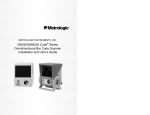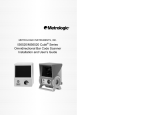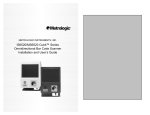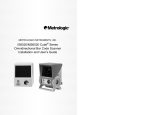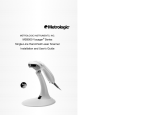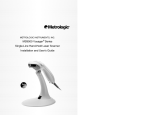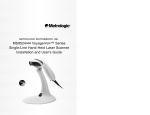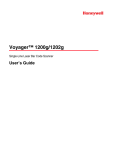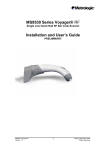Download Metrologic Hand-Held Scanner User`s guide
Transcript
MS9500 Voyager™ Series Single-Line Hand-Held Laser Scanner Installation and User’s Guide Locations USA Corporate Headquarters Metrologic Instruments, Inc. 90 Coles Road Blackwood, NJ 08012-4683 Customer Service: 1-800-ID-METRO Tel: 856-228-8100 Fax: 856-228-6673 Email: [email protected] www.metrologic.com Europe Metrologic Instruments GmbH Dornierstrasse 2 82178 Puchheim b. Munich, Germany Tel: 49-89-89019-0 Fax: 49-89-89019-200 Email: [email protected] South America Metrologic South America Rua Flórida, 1821 - 5° Andar São Paulo, SP CEP: 04571-090 Tel: 5511-5505-6568 Fax: 5511-5505-1681 Email: [email protected] Asia Metrologic Asia (Pte) Ltd. 31 Kaki Bukit Road 3 #05-08 Techlink Singapore 417818 Tel: 65-842-7155 Fax: 65-842-7166 Email: [email protected] Brazil Metrologic do Brasil Ltda. Rua Flórida, 1821 - 5° Andar São Paulo, SP CEP: 04571-090 Tel: 5511-5505-2396 Fax: 5511-5505-2301 Email: [email protected] Copyright 2000 by Metrologic Instruments, Inc. All rights reserved. No part of this work may be reproduced, transmitted, or stored in any form or by any means without prior written consent, except by reviewer, who may quote brief passages in a review, or provided for in the Copyright Act of 1976. Products and brand names mentioned in this document are trademarks of their respective companies. MLPN 2410 Printed in USA ii January 2000 iii Table of Contents Introduction ............................................................................................. 1 Scanner and Accessories ........................................................................ 2 Quick Start.............................................................................................. 3 Installing the Scanner to the Host System ............................................... 4 Disconnecting PowerLink Cables from the Scanner................................. 5 How to Use CodeGate – MS9540 Only.................................................... 6 Assembling the Stand ............................................................................. 7 Scanner Parts ......................................................................................... 9 Audible Indicators.................................................................................... 10 Visual Indicators...................................................................................... 11 Failure Modes ......................................................................................... 13 Programming Modes............................................................................... 14 Upgrading the Flash ROM Firmware ....................................................... 17 Labels ..................................................................................................... 18 Depth of Field ......................................................................................... 19 IR Activation ........................................................................................... 20 Maintenance ........................................................................................... 21 Applications and Protocols ...................................................................... 22 Trouble Shooting Guide .......................................................................... 23 R232 Demonstration Program ................................................................. 28 iv Table of Contents (continued) Appendix A Design Specifications........................................................................... 29 Appendix B Default Settings.................................................................................... 30 Appendix C Pin Assignments .................................................................................. 35 Appendix D Warranty and Disclaimer...................................................................... 38 Appendix E Notices................................................................................................. 39 Appendix F Patents................................................................................................. 41 Addendum .............................................................................................. 42 Index....................................................................................................... 43 v Introduction The Voyager™ MS9500 Series single-line hand-held scanners include both the MS9520 and MS9540. The Voyager MS9540 features Metrologic’s patented CodeGate™ technology. CodeGate is an intuitive scanning system that is ideal for all scanning applications, including menu-scanning, point-of-sale, document processing, and inventory control. CodeGate works hand-in-hand with Metrologic’s patented automatictriggering scheme. Simply present a bar code to the scanner; the highvisibility 650-nanometer laser is automatically activated allowing the user to easily select the bar code to be scanned. Press the CodeGate button and the data is transmitted to the host system. Equipped with both ‘in-stand’ and ‘out-of-stand’ operation, Voyager can be used as both a hand-held and fixed projection scanner. Voyager automatically senses when it is placed in the stand and de-activates the CodeGate button. If the advantage of CodeGate technology is unnecessary in your application, then the MS9520 is the Voyager of choice. The MS9520 is packed with all of the same features as the MS9540, with the exception of CodeGate. Metrologic has included many standard features such as: user upgradeable Flash ROM, PowerLink user-replaceable cables, MetroSet™ and METROSELECT® configuration, EMI rating of Class B, data editing (parsing) capability using Bits ‘n’ Pieces™, and a 2-year warranty. Voyager MS9520 – 9 MS9520 – 11 MS9520 – 41 Voyager - CodeGate MS9540 – 9 MS9540 – 11 MS9540 – 41 MS9520 – 47 MS9540 – 47 1 Interface OCIA IBM 468X/469X Full RS-232C and Light Pen Emulation Keyboard Wedge and Stand-Alone Keyboard Scanner and Accessories The following list of parts may or may not be included in the MS9500 kit. • Voyager MS9520 Single-Line Laser Scanner, or Voyager MS9540 – CodeGate™ Single-Line Laser Scanner • AC to DC Power Transformer – Regulated 5.2VDC @ 650 mA output . One of the following may be included: 120 V United States: MLPN 45-45593 220 V – 240 V Continental European: MLPN 45-45591 220 V – 240 V United Kingdom: MLPN 45-45592 • PowerLink Cable with built in power jack. One of the following may be included: Standard: MLPN 53xxx* - 2.7 m (9’) coiled cord, long strain relief or Optional: MLPN 54xxx* - 2.1 m (7’) straight cord, short strain relief *xxx specifies connection to host • Stand with mounting accessories Clip-in Stand: MLPN 46-46055, or Mask Stand: MLPN 46-46128 • Installation and User’s Guide – MLPN 2410 Available on Metrologic website – www.metrologic.com • MetroSelect Scanner Configuration Guide – MLPN 2407 Available on Metrologic website – www.metrologic.com Other items may be ordered for the specific protocol being used. To order additional items, contact the dealer, distributor or call Metrologic’s Customer Service Department at 1-800-ID-METRO or 1-800-436-3876. Caution: To maintain compliance with applicable standards, all circuits connected to the scanner must meet the requirements for SELV (Safety Extra Low Voltage) according to EN 60950. To maintain compliance with standard CSA C22.2 No. 950/UL 1950 and norm EN 60950, the power source should meet applicable performance requirements for a limited power source. 2 Quick Start 3 2 1 1. Connect the 10-pin RJ45 male connector into the jack on the Voyager. You will hear a ‘click’ when the connection is made. 2. Connect the L-shaped plug of the power supply into the power jack on the PowerLink cable. 3. Connect the power supply into an AC outlet. Make sure the AC input requirements of the power supply match the AC outlet. 4 4. When the Voyager is ready to scan, the green LED will turn on, the red LED will flash and the scanner will beep once. 5 5. Place a bar code in front of the scanning window. The scanner will beep once and flash the red LED if the bar code was successfully decoded. For the MS9540, press the CodeGate button to transmit the data. NOTE: Voyager is shipped from the factory programmed with default settings. Refer to the METROSELECT® Programming Guide for instructions on how to configure the scanner. 3 Installing the Scanner to the Host System 1. Turn off the host system. 2. Make the proper PowerLink cable connections to the scanner. Please refer to the Quick Start section of this manual for proper installation of the cable and power supply. NOTE: If the Voyager is receiving power from the host system, please skip step #2 and step #3 in the Quick Start section of this manual. 3. Connect the PowerLink cable to the proper port on the host system. 4. Turn on the host system. 1 2 4 3 Note: Plugging the scanner into a port on the host system does not guarantee that scanned information will be communicated properly to the host system. The scanner is shipped from the factory programmed with default settings. Please refer to the MetroSelect Configuration Guide (MLPN 2407) for instructions on changing the scanner’s configuration. In addition, please check that the scanner and host system are using the same communication protocol. 4 Disconnecting PowerLink Cables from the Scanner Before removing the cable from the scanner, Metrologic recommends that the power on the host system is off and the power supply has been disconnected from the PowerLink cable. 1 2 1. Locate the small ‘pin-hole’ on the top of the unit near the bottom of the Voyager logo. 2. Bend an ordinary paperclip into the shape shown above. 3. Insert the paperclip (or other small metallic pin) into the small ‘pinhole’. 4. You will here a faint ‘click’. Pull gently on the strain-relief of the PowerLink cable and it will slide out of the scanner. 5 How to Use CodeGate – MS9540 Only • Auto trigger activates 1 the laser • Place the laser line on the bar code • Press the CodeGate button to transmit the data 2 3 Two Modes of Operation • Auto-trigger while in the stand • Bar code is automatically decoded and transmitted • CodeGate activates when removed from the stand • Bar code data is transmitted when the CodeGate button is pressed 6 Assembling the Stand Kit #46-46055 Contains: a. Stand b. Apron c. Screw, M3 x 6 mm long d. Washer, #5 x .5 OD e. Stand Anchor f. Wood Screw, #8 Round Head g. Base (mlpn 36-00343) (mlpn 50-50440) (mlpn 18-18670) (mlpn 18-18671) (mlpn 50-50449) (mlpn 18-18057) (mlpn 36-36080) Qty 1 Qty 1 Qty 2 Qty 2 Qty 1 Qty 4 Qty 1 c. d. a. b e. g. f. There are 2 options for assembling the stand. The first option allows the stand to be self-supporting and moved freely or placed anywhere on the countertop. The second option is used if the stand will be bolted/hard-mounted to the countertop. Stand Option 1: Self-supported Step 1 Slide the apron (mlpn 50-50440) over the stand (mlpn 36-00343). Step 2 Position the stand so it sits under the tab on the apron. Then secure the apron to the stand using the M3 x 6 mm screws (mlpn18-18670) and the #5 washers (mlpn 18-18671) provided. Step 2 Tab Step 1 Apron Apron Stand #5 Washer M3 Screw 7 Stand Assembling the Stand (continued) Stand Option 2: Hard-mounted to countertop 2.00 in Step 1 Drill four #39 holes in the countertop. 2.00 in #8 Wood Screw Step 2 Secure the base (mlpn 36-36080) Anchor to the countertop with the four #8 wood screws (mlpn 18-18057) provided. Base Step 3 Screw the anchor (mlpn 50-50449) onto the base until it sits flush. Step 4 Remove the logo plate on the stand by gently using an exacto knife to release the plate hook. Step 5 Position the stand over the base assembly. Step 6 Secure the stand to the base assembly by tightening the set screw located under the logo plate. Step 7 Snap the logo plate back into place. 8 Scanner Parts Green, Yellow and Red LEDs CodeGate Button* Output Window Stand Cable Connection Stand Apron *This feature is not available on the MS9520 9 Audible Indicators When the Voyager is in operation, it provides audible feedback. These sounds indicate the status of the scanner. Eight settings are available for the tone of the beep (normal, 6 alternate tones and no tone). To change the tone, refer to the MetroSelect Programming Guide MLPN 2407. One Beep When the scanner first receives power, the green LED will turn on, then the red LED will flash and the scanner will beep once. (The red LED will remain on for the duration of the beep.) The scanner is ready to scan. When the scanner successfully reads a bar code, the red LED will flash and the scanner beeps once (if programmed to do so). If the scanner does not beep once and the green light does not flash, then the bar code has not been successfully read. Razzberry Tone This tone is a failure indicator. Refer to “Failure Modes" page 13. Three Beeps - During Operation When entering configuration mode, the red LED will flash while the scanner simultaneously beeps three times. The red and green LEDs will continue to flash while in this mode. Upon exiting configuration mode, the scanner will beep three times, and the LEDs will stop flashing. When configured, 3 beeps can also indicate a communications timeout during normal scanning mode. When using one-code-programming, the scanner will beep three times (the current selected tone), followed by a short pause then by a high tone and a low tone. This tells the user that the single configuration bar code has successfully configured the scanner. Three Beeps - On Power Up 10 This is a failure indicator. Refer to “Failure Modes” on page 13. 11 Visual Indicators There are three LED indicators (green, red and yellow) located on the head of the MS9500. When the scanner is on, the flashing or stationary activity of the LEDs indicates the status of the current scan and the scanner. Green, Red & Yellow LEDs are off The LEDs will not be illuminated if the scanner is not receiving power from the host or transformer. The scanner is stand-by mode, and CodeGate is enabled. Present a bar code to the scanner and the green LED will turn on when the laser turns on. Steady Yellow The CodeGate button is not active. If a bar code is in the scan field, the laser will turn on. The bar code will be decoded and transmitted to the host automatically. Steady Green When the laser is active, the green LED is illuminated. The green LED will remain illuminated until the laser is deactivated. Steady Green and Single Red Flash When the scanner successfully reads a bar code, the red LED will flash and the scanner will beep once. If the red LED does not flash or the scanner does not beep once, then the bar code has not been successfully read. Steady Green and Steady Red After a successful scan, the scanner transmits the data to the host device. Some communication modes require that the host inform the scanner when data is ready to be received. If the host is not ready to accept the information, the scanner’s red LED will remain on until the data can be transmitted. 12 Visual Indicators (continued) Alternating Flashing of Green and Red This indicates the scanner is program mode. A razzberry tone indicates that an invalid bar code has been scanned while in this mode. Steady Red, Green off This indicates the scanner may be waiting for communication from the host. 13 Failure Modes Flashing Green and one Razzberry Tone This indicates the scanner has experienced a laser subsystem failure. Return the unit for repair to an authorized service center. Flashing Red and Green with Two Razzberry Tones This indicates the scanner has experienced a scanning mechanism failure. Return the unit for repair to an authorized service center. Continuous Razzberry Tone with all LEDs off If, upon power, the scanner emits a continuous razzberry tone, then the scanner has an experienced an electronic failure. Return the unit for repair to an authorized service center. Three Beeps – on power up If the scanner beeps 3 times on power up then, the nonvolatile memory (NovRAM) that holds the scanner configuration has failed. Return the unit for repair to an authorized service center. 14 Programming Modes The MS9500 Voyager has 3 modes of programming. Bar Codes: Voyager can be configured by scanning the bar codes located in the METROSELECT® Configuration Guide (MLPN 2407). Please refer to this guide for instructions. This manual can be downloaded for FREE from Metrologic’s website (www.metrologic.com). MetroSet™: This user-friendly Windows-based configuration program allows you to simply ‘point-and-click’ at the desired scanner options. This program can be downloaded for FREE from Metrologic’ website (www.metrologic.com), or set-up disks can be ordered by calling 1-800ID-METRO. Serial Programming: This mode of programming is ideal for OEM applications. This mode gives the end-user the ability to send a series of commands using the serial port of the host system. The commands are equivalent to the numerical values of the bar codes located in the MetroSelect Configuration Guide (MLPN 2407). How does Serial Programming work? 1. Each command sent to the scanner is the ASCII representation of each numeral in the configuration bar code. The entire numeric string is framed with an ASCII [stx] and an ASCII [etx]. EXAMPLE #1: Command for Disabling Codabar Command = [stx]100104[etx] String Sent to Scanner = 02h 31h 30h 30h 31h 30h 34h 03h (All values are hexadecimal). 2. If the command sent to the scanner is valid, the scanner will respond with an [ack]. 3. If the command sent to the scanner in invalid, the scanner will respond with a [nak]. NOTE: If this occurs, the end-user must start over at the very beginning of the configuration sequence. Simply re-tranmsitting the invalid command will not work, you must start over. 15 Programming Modes (continued) 4. During programming, the motor and laser remain active. YOU CANNOT SCAN ANY BAR CODES WHILE IN PROGRAM MODE. 5. There is a 20 second window between commands. If a 20 second timeout occurs, the scanner will send a [nak] and you must start over. 6. To enter serial program mode, send the following command [stx]999999[etx]. 7. To exit serial program mode, send the following command [stx]999999[etx], the scanner will respond with an [ack] and a long beep. 8. This mode uses the current Baud Rate, Parity, Stop Bits and Data Bits settings that are configured in the scanner. The default settings of the scanner are 9600, Space, 2, 7 respectively. If a command is sent to the scanner to change any of these settings, the change will NOT take effect until after serial program mode is exited. EXAMPLE #2: The following example will set the scanner to the factory default settings, Disable Scanning of Code 128 bar codes, change the beeper tone, and add a “G” as a programmable prefix. FEATURE HOST COMMAND Enter Program Mode [stx]999999[etx] Load Defaults [stx]999998[etx] Disable Code 128 [stx]100113[etx] Alternate Tone 1 [stx]318565[etx] Prog. Prefix #1 [stx]903500[etx] Code Byte 0 [stx]0[etx] Code Byte 7 [stx]7[etx] Code Byte 1 [stx]1[etx] Exit Program Mode [stx]999999[etx] The scanner will emit a long beep! ASCII REPRESENTATION 02h 39h 39h 39h 39h 39h 39h 03h 02h 39h 39h 39h 39h 39h 38h 03h 02h 31h 30h 30h 31h 31h 33h 03h 02h 33h 31h 38h 35h 36h 35h 03h 02h 39h 30h 33h 35h 30h 30h 03h 02h 30h 03h 02h 37h 03h 02h 31h 03h 02h 39h 39h 39h 39h 39h 39h 03h SCANNER RESPONSE [ack] or 06h [ack] or 06h [ack] or 06h [ack] or 06h [ack] or 06h [ack] or 06h [ack] or 06h [ack] or 06h [ack] or 06h The commands sent to the scanner do not include the small superscripted ‘3’ that you see in front of each bar code string in the MetroSelect manual. THE ‘3’ SHOULD NOT BE SENT, IT IS A CODE TYPE DESIGNATION ONLY! As you will note for commands requiring additional bar codes to be scanned (such as prefixes, suffixes, timeouts, etc.), simply send the code bytes in the same order that you would normally scan the bar codes. 16 Programming Modes (continued) EXAMPLE #3: The following example shows the events that occur when an invalid bar code is sent. This sample will load the factory default settings and then set the baud rate to 19200. FEATURE HOST COMMAND SCANNER ASCII REPRESENTATION Enter Program Mode [stx]999999[etx] 02h 39h 39h 39h 39h 39h 39h 03h Load Defaults [stx]99999:[etx] 02h 39h 39h 39h 39h 39h 3Ah 03h Invalid command was sent, you must start over! Enter Program Mode [stx]999999[etx] 02h 39h 39h 39h 39h 39h 39h 03h Load Defaults [stx]999998[etx] 02h 39h 39h 39h 39h 39h 39h 03h 19200 Baud Rate [stx]415870[etx] 02h 34h 31h 35h 38h 37h 30h 03h Exit Program Mode [stx]999999[etx] 02h 39h 39h 39h 39h 39h 39h 03h The scanner will emit a long beep! RESPONSE [ack] or 06h [nak] or 15h [ack] or 06h [ack] or 06h [ack] or 06h [ack] or 06h This example illustrates two important points. First, if an invalid command is sent from the host, the scanner responds with a [nak] and the end-user must start over from the beginning. Second, if a command is sent to change the Baud Rate, the new baud rate does not take effect until after the end-user exits program mode. ABBREVIATED ASCII TABLE Character Hex Value Decimal Value [STX] 02h 2 [ETX] 03h 3 [ACK] 06h 6 [NAK] 15h 21 0 30h 48 1 31h 49 2 32h 50 3 33h 51 4 34h 52 5 35h 53 6 36h 54 7 37h 55 8 38h 56 9 39h 57 17 Upgrading the Flash Rom Firmware The Meteor program is a functional component of Metrologic’s new line of flash-based scanners. This program allows the user of a Metrologic scanner to quickly upgrade to a new or custom version of software. It requires the use of a personal computer running under Windows 95 or greater and the use of a communication port. The user merely connects the scanner to a communications port of the PC, launches the Meteor program, and blasts off to new software upgrades. Each MS9500, regardless of the version number or communication protocol, can be upgraded. In other words, all RS232 (-41), keyboard wedge (-47), light pen (-41), OCIA (-9) and IBM 468X/469X (-11) units can be upgraded. To upgrade all units, a power supply and PowerLink cable (MLPN 54012) are required. The upgrades and custom software versions will be supplied by Metrologic in files called Motorola S-record files. These files contain all the information needed to upgrade the scanner. Simply add this file to the working directory or retrieve from its current location. The program guides the user with its simplistic one click approach. The user must first select the file; once selected and verified, the file is ready to be used in the upgrade. Press the button to upgrade the scanner, the unit will go into a “flash mode” – both the green and red LEDs will be on. The user can follow the progress of the upgrade by watching the screen for details. When the upgrade is complete, the scanner will respond with its normal one beep on power up. If two beeps occur, the scanner did not upgrade properly. (Contact Metrologic for additional details). 18 Labels Each scanner has a label on the back of the unit. This label has the model number, date of manufacture, serial number, CE and caution information. The following is an example of this label: AVOID EXPOSURE laser light emitted from this aperture Patent information-see manual FCC and ICES-0003 information-see manual Warranty VOID if case opened. Contains no user servicable components. Complies with 21CFR 1040, 1040.01 & 1040.11 NACH EN60825-1:1994/A11:1996 5V Metrologic Instruments Inc. Manufactured in Blackwood New Jersey, USA Model: MS9540 January 2000 RS232 5V Prototype 3500020166 AVOID EXPOSURE Laser Light is emitted from the aperture oo CAUTION LASER LIGHT DO NOT STARE INTO BEAM 1.0 MILLIWATT (PEAK) VISIBLE LASER DIODE CLASS ll LASER PRODUCT LASERKLASSE 1 PRODUKT 19 Depth of Field Distance: Scanner Face 2.5” [64 mm] Scan Width at 0.0” [0 mm] A 3.4” [86 mm] B 1.0” [25.4 mm] 4.4” [112 mm] 4.8” [122 mm] E 2.0” [51 mm] 2.5” [64 mm] G 7.1” [180 mm] 5.0” [127 mm] H 8.5” [216 mm] J 6.5” [165 mm] 9.8” [249 mm] 8.0” [203 mm] 11.7” [297 mm] 10.0” [254 mm] Width of Scan Field Minimum Bar Code Element Width A B C D E F G H J K mm .13 .15 - - .19 - .25 .33 .53 - mils 5.2 5.7 - - 7.5 - 10 13 21 - 20 IR Activation 2.5” [64 mm] Scan Width at Face Distance From Face 0.0” [0 mm] Short Range IR 6.2” [158 mm] Long Range IR 12.6” [320 mm] Width of Scan Field 21 4.0” ± 1.0” [102 mm ± 25.4mm] 11.0” ± 2.0” [229 mm ± 51 mm] Maintenance Smudges and dirt can interfere with the proper scanning of a bar code. Therefore, the output window will need occasional cleaning. 1. Spray glass cleaner onto lint free, non-abrasive cleaning cloth. 2. Gently wipe the scanner window. 22 Applications and Protocols The model number on each scanner includes the scanner number and factory default communications protocol. Scanner Version Identifier MS9520 MS9540 41 Full RS-232C/Light Pen Emulation MS9520 MS9540 47 Keyboard Wedge, Stand-Alone Keyboard and RS-232 Transmit/Receive MS9520 MS9540 9 MS9520 MS9540 11 Communication Protocol(s) OCIA and RS-232 Transmit/Receive IBM 46XX and Full RS-232C The MS9500 Series Hand-Held Laser Scanner with built-in PC Keyboard Wedge Interface is designed to be used for Keyboard emulation only. Many RS-232 programmable functions available in other Metrologic scanners are also available as keyboard wedge functions. The following are the most important selectable options specific to the keyboard wedge. Keyboard Type • • • **AT (includes IBM® PS2 models 50, 55, 60, 80) XT IBM PS2 (includes models 30, 70, 8556) Keyboard Country Type • • • • • **USA French Italian Belgium Japanese • • • • United Kingdom German Spanish Swiss **Default setting. Refer to Appendix B pages 30-34 for default settings. Refer to the METROSELECT® Programming Guide (MLPN 2407) for information on how to change the default settings. 23 Trouble Shooting Guide The following guide is for reference purposes only. Contact a Metrologic representative at 1-800-ID-Metro or 1-800-436-3876 to preserve the limited warranty terms. All Interfaces MS9500 Series Troubleshooting Guide Symptoms Possible Causes Solution No LEDs, beep or laser No power is being supplied to the scanner Check transformer, outlet and power strip. Make sure the cable is plugged into the scanner No LEDs, beep, or laser No power is being supplied to the scanner from host Some host systems cannot supply enough current to power Voyager. A power supply may be needed. 3 Beeps on power up Non-volatile RAM failure Contact a Metrologic Representative, if the unit will not hold the programmed configuration Continuous razz tone on power up RAM or ROM failure Contact a Metrologic Representative, if the unit will not function Razz tone and green LED flash at power up VLD failure Contact a Metrologic Representative Razz tone, red and green LEDs flash at power up Scanning mechanism failure Contact a Metrologic Representative Unit scans, Communicates and beeps twice Same symbol timeout set too short Adjust same symbol timeout for a longer time 24 Troubleshooting Guide (continued) Symptoms Possible Causes Solution The unit powers up, but does not scan/or beep Beeper disabled. No tone selected Enable beeper. Select tone The unit powers up, but does not scan and/or beep Scanning a particular symbology that is not enabled UPC/EAN, Code 39, interleaved 2 of 5, Code 93, Code 128 and Codabar are enabled by default. Verify that the type of bar code being read has been selected The unit powers up, but does not scan and/or beep The scanner has been programmed for a character length lock, or a minimum length and bar code being scanned does not satisfy the programmed criteria Verify that the bar code that is being scanned falls into the criteria (Typical of Non-UPC/EAN codes) The scanner defaults to a minimum of 3 character bar code The unit scans a bar code, but locks up after the first scan red LED stays on The scanner is configured to support some form of host handshaking but is not receiving the signal If the scanner is setup to support ACK/NAK, RTS/CTS, XON/XOFF or D/E, verify that the host cable and host are supporting the handshaking properly The unit scans, but the data transmitted to the host is incorrect The scanner’s data format does not match the host system requirements Verify that the scanner’s data format matches that required by the host. Most sure that the scanner is connected to the proper host port 25 Troubleshooting Guide (continued) Symptoms Possible Causes Solution Scanner beeps at some bar codes and NOT for others of the same bar code symbology The print quality of the bar code is suspect Check print mode. The type of printer could be the problem. Change print settings. i.e. change to econo mode or high speed Scanner beeps at some bar codes and NOT for others of the same bar code symbology The aspect ratio of the bar code is out of tolerance Check print mode. The type of printer could be the problem. Change print settings. i.e. change to econo mode or high speed Scanner beeps at some bar codes and NOT for others of the same bar code symbology The bar code may have been printed incorrectly Check if it is a check digit/character/or border problem Scanner beeps at some bar codes and NOT for others of the same bar code symbology The scanner is not configured correctly for this type of bar code Check if check digits are set properly Scanner beeps at some bar codes and NOT for others of the same bar code symbology The minimum symbol length setting does not work with the bar code Check if the correct minimum symbol length is set 26 Troubleshooting Guide (continued) Symptoms Possible Causes Solution Configuration is not correct Make sure the scanner is configured for the appropriate mode. Check internal jumper Configuration is correct Make sure that the proper PC type AT, PS2 or XT is selected. Verify correct country code and data formatting are selected. Adjust intercharacter delay symptom The unit is transmitting each character twice Configuration is not correct Increase interscan code delay setting. Adjust whether the F0 break is transmitted. It may be necessary to try this in both settings Alpha characters show as lower case Computer is in Caps Lock mode Enable Caps Lock detect setting of the scanner to detect whether the PC is operating in Caps Lock Everything works except for a couple of characters These characters may not be supported by that country’s key look up table Try operating the scanner in Alt mode The unit scans the bar code but there is no data The unit scans but the data is not correct 27 Troubleshooting Guide (continued) Symptoms Possible Causes Solution Power-up OK and scans OK ,but does not communicate properly to the host Com port at the host is not working or configured properly Check to make sure that the baud rate and parity of the scanner and the communication port match and the program is looking for “RS-232” data Power-up OK and scans OK ,but does not communicate properly to the host Cable not connected to the proper com port Check to make sure that the baud rate and parity of the scanner and the communication port match and the program is looking for “RS-232” data Power-up OK and scans OK ,but does not communicate properly to the host Cable not connected to the proper com port Check to make sure that the baud rate and parity of the scanner and the communication port match and the program is looking for “RS-232” data The host is receiving data but the data does not look correct The scanner and host may not be configured for the same interface parameters Check that the scanner and the host are configured for the same interface parameters Characters are being dropped Inter-character delay needs to be added to the transmitted output Add some inter-character delay to the transmitted output by using the MetroSelect Programming Guide MLPN 2407 28 RS-232 Demonstration Program If an RS-232 scanner is not communicating with your IBM compatible PC, key in the following BASIC program to test that the communication port and scanner are working. This program is for demonstration purposes only. It is only intended to prove that cabling is correct, the com port is working, and the scanner is working. If the bar code data displays on the screen while using this program, it only demonstrates that the hardware interface and scanner are working. At this point, investigate whether the application software and the scanner configuration match. If the application does not support RS-232 scanners, a software wedge program that will take RS-232 data and place it into a keyboard buffer may be needed. This program tells the PC to ignore RTS-CTS, Data Set Ready (DSR) and Data Carrier Detect (DCD) signals. If the demonstration program works and yours still does not, jumper RTS to CTS and Data Terminal Reading (DTR) to DCD and DSR on the back of your PC. 10 20 30 35 40 50 60 70 100 CLS ON ERROR GOTO 100 OPEN “COM1:9600,S,7,1,CSO,DSO,CD0,LF” AS#1 PRINT “SCAN A FEW BAR CODES” LINE INPUT #1, BARCODE$ PRINT BARCODE$ K$ = INKEY$: IF K$ = CHR$(27) THEN GOTO 32766 GOTO 40 PRINT “ERROR NO.”; ERR ;“PRESS ANY KEY TO TERMINATE.” 110 KK$ = INKEY$: IF K$ = “”THEN GOTO 110 32766 CLOSE: SYSTEM 32767 END 29 Appendix A – Design Specifications Operational Light Source Laser Power Depth of Scan Field Scan Speed Scan Pattern Minimum Bar Width InfraRed Activation Decode Capability System Interfaces Print Contrast Number Characters Read Roll, Pitch, Yaw Beeper Operation Indicators (LED) Visible Laser Diode 650 nm ± 10 nm 0.96 mW (peak) 0 mm – 203 mm (0” – 8” for 0.330 mm (13 mil) bar code at default setting 72 scan lines per second Single scan line 0.127 mm (5.0 mil) Long Range: 0 mm – 279 mm ± 51 mm (0” – 11” ± 2”) Short Range: 0mm – 102 mm ± 25 mm (0” – 4” ± 1”) Autodiscriminates all standard bar codes’ for others call Metrologic RS232, PC Keyboard Wedge, Stand-Alone Keyboard, OCIA, IBM 468X/469X, Light Pen Emulation 35% minimum reflectance difference Up to 80 data characters (Maximum number will vary based on symbology and density) 42°, 68°, 52° 7 tones or no beep Green = laser on, ready to scan Red = good read Yellow (MS9540 Only) = CodeGate button is inactive (on). CodeGate button is active (off) Mechanical Length Width-Handle Width-Head Depth Weight Cable 198 mm (7.8”) 45 mm (1.8”) 78 mm (3.1”) 40 mm (1.6”) 149 g (5.25 oz) Standard 2.7 m (9’) coiled; optional 2.1 m (7’) straight Electrical Input Voltage Power – Operating Power – Standby Current – Operating Current – Standby DC Transformers Laser Class EMC 5 VDC ± 0.25 V 0.825 W 0.600 W 165 mA @ 5 VDC 120 mA @ 5 VDC Class 2; 5.2V @ 650 mA CDRH: Class II; EN60825-1:1994/A11:1996 Class 1 FCC Class B Environmental Operating Temperature Storage Temperature Humidity Light Levels Shock Contaminants Ventilation 0°C to 40° (32° to 104°F) -40°C to 60°C (-40°F to 140°F) 5% to 95% relative humidity, non-condensing Up to 4842 Lux (450 footcandles) Designed to withstand 1.5 m (5’) drops Sealed to resist airborne particulate contaminants None required 30 Appendix B – Default Settings Many functions of the scanner can be “programmed” – that is, enabled or disabled. The scanner is shipped from the factory programmed to a set of default conditions. The default parameter of the scanner has an asterisk (*) in the charts on the following pages. If an asterisk is not in the default column then the default setting is OFF or DISABLED. Every communication does not support every parameter. If the communication supports a parameter listed in the charts on the following pages, a check mark will appear. PARAMETER Normal Scan Mode DEFAULT * Continuous Scan Mode Blinky Scan Continuous Blinky Scan Custom (one shot) Scan Long-Range In-Stand * Short-Range In-Stand Long-Range Out-of-Stand Short-Range Out-ofStand CodeGate Active InStand CodeGate Inactive InStand CodeGate Active Out-of Stand CodeGate Inactive Out-of Stand * UPC/EAN * Code 128 * Code 93 * Codabar * Interleaved 2 of 5 (ITF) * * * MOD 10 check on ITF Code 11 Code 39 Full ASCII Code 39 31 * OCIA RS-232 LIGHT PEN IBM 46XX KBW Appendix B – Default Settings (continued) PARAMETER DEFAULT OCIA RS-232 LIGHT PEN IBM 46XX KBW Mod 43 Check on Code 39 MSI-Plessy 10/10 Check Digit MSI-Plessy Mod 10 Check Digit * Paraf Support ITF ITF Symbol Lengths Minimum Symbol Length Symbol Length Lock Bars High as Code 39 Variable 3 None * Spaces High as Code 39 Bars High as Scanned Spaces High as Scanned DTS/SIEMENS DTS/NIXDORF * NCR F NCR S Poll light pen source Beeper tone Beep/transmit sequence Communication timeout Razzberry tone on timeout Normal Before transmit None Three beeps on timeout Same symbol rescan timeout 250 msecs Same symbol rescan timeout 375 msecs Same symbol rescan timeout: 500 msecs) Same symbol rescan timeout 625 msecs 32 Appendix B – Default Settings (continued) PARAMETER DEFAULT Same symbol rescan timeout 750 msecs Same symbol rescan timeout 875 msecs * Same symbol rescan timeout: 1000 msecs No Same symbol timeout Infinite Same symbol timeout Inter-character delay Program able in 1 msec steps (max 255 msecs) 1 msecs 10 msecs in KBW Number of scan buffers 4 Transmit UPC-A check digit Transmit UPC-E check digit * Expand UPC-E Convert UPC-A to EAN13 Transmit lead zero on UPC-E Transmit UPC-A number system * Transmit UPC-A Manufacturer ID# * Transmit UPC –A Item ID# * Transmit Codabar Start/Stop Characters CLSI Editing (Enable) Transmit Mod 43 Check digit on Code 39 Transit Mod 10/ITF Transmit MSI-Plessy Parity Space Baud Rate 9600 8 Data Bits 7 Data Bits * Stop Bits 2 33 OCIA RS-232 LIGHT PEN IBM 46XX KBW Appendix B – Default Settings (continued) PARAMETER DEFAULT OCIA RS-232 LIGHT PEN IBM 46XX KBW Transmit Sanyo ID Characters Nixdorf ID LRC Enabled UPC Prefix UPC Suffix Carriage Return * Line Feed-Disabled by default in KBW * Tab Prefix Tab Suffix “DE” Disable Command “FL” Laser Enable Command DTR Handshaking support RTS/CTS Handshaking Character * Message RTS/CTS XON/XOFF Handshaking ACK/NAK as code 39 as code 39 as code 39 Two Digit Supplements Five Digit Supplements Bookland 977 (2 digit) Supplemental Requirement Supplements are not Required * Two Digit Redundancy * Five digit Redundancy 34 Appendix B – Default Settings (continued) PARAMETER 100 msec to Find Supplement Programmable in 100 msec steps (max 800 msec) DEFAULT 7 avail Programmable Prefix characters 10 avail Suffix characters 10 avail Prefixes for Individual Code types Editing 800 msec Function/control Key Support 35 LIGHT PEN as code 39 Programmable Code Lengths Minimum Element width Programmable in 5.6 msec steps RS-232 * Coupon Code 128 Inter Scan-Code delay programmable (100 msec steps) OCIA 1 msec IBM 46XX KBW Appendix C The MS9520 and MS9540 scanner interfaces terminate to a 10-pin modular jack. The serial # label indicates the interface enabled when the scanner is shipped from the factory. 1 10 Function Ground RS-232 Transmit Output RS-232 Receive Input RDATA RDATA Return Clock in Clock out Clock in Return/Clock out Rtrn +5VDC Shield Ground MS9520-47 & MS9540-47 Keyboard Wedge and StandAlone Keyboard Function Ground RS-232 Transmit Output RS-232 Receive Input PC Data PC Clock KB Clock PC +5V KB Data +5VDC Shield Ground MS9520-41 & MS9540-41 RS-232C and Light Pen Emulation MS9520-11 & MS9540-11 IBM 468X/469X MS9520-9 & MS9520-9 OCIA Pin 1 2 3 4 5 6 7 8 9 10 Pin 1 2 3 4 5 6 7 8 9 10 Function Ground RS-232 Transmit Output RS-232 Receive Input RTS Output CTS Input DTR Input/LTPN Source Reserved LTPN Data +5VDC Shield Ground Function Ground RS-232 Transmit Output RS-232 Receive Input RTS Output CTS Input DTR Input IBM B-Transmit IBM A+ Receive +5VDC Shield Ground Options listed are program/cable selections 36 Appendix C (continued) Cable Connector Configurations “Standard” PowerLink cable MLPN 53000 6 1 9 5 9-pin D-type female connector to the PC Pin 1 2 3 4 5 6 7 8 9 37 Function Shield Ground RS-232 Transmit Output RS-232 Receive Input DTR Input/Light Pen Source Power/Signal Ground Light Pen Data CTS Input RTS Output +5VDC 9-Pin D-Type Connector Appendix C (continued) Cable Connector Configuration The PowerLink cable is terminated with a 5-pin DIN female connector on one end, and a 6-pin mini DIN male on the other. 4 1 2 5 2 3 1 4 3 6 5 PowerLink Cable 5-Pin DIN, Female 6-Pin DIN, Male Metrologic will supply an adapter cable with a 5-pin DIN male connector on one end and a 6-pin mini DIN female connector on the other. 2 5 3 4 1 1 2 3 4 5 6 5-Pin Din, Male Adapter Cable According to the termination required, connect the appropriate end of the adapter cable to the PowerLink cable, leaving the necessary termination exposed for connecting to the keyboard and the keyboard port on the PC. The pin assignments are as follows: PowerLink Cable Pin 1 2 3 4 5 5-pin Female DIN Function Keyboard Clock Keyboard Data No Connect Power Ground +5 Volts DC 6-pin Male Mini-DIN Pin Function 1 Keyboard Data 2 No Connect 3 Power Ground 4 +5 Volts DC 5 PC Clock 6 No Connect Adapter Cable Pin 1 2 3 4 5 5-pin Male DIN Function PC Clock PC Data No Connect Power Ground +5 Volts DC 6-pin Female Mini-DIN Pin Function 1 Keyboard Data 2 No Connect 3 Power Ground 4 +5 Volts DC 5 Keyboard Clock 6 No Connect 38 Appendix D – Warranty and Disclaimer Limited Warranty The MS9500 scanners are manufactured by Metrologic at its Blackwood, New Jersey, USA facility. The MS9500 scanners have a two (2) year limited warranty from the date of manufacture. Metrologic warrants and represents that all MS9500 scanners are free of all defects in material, workmanship and design, and have been produced and labeled in compliance with all applicable US Federal, state and local laws, regulations and ordinances pertaining to their production and labeling. This warranty is limited to repair, replacement of Product or refund of Product price at the sole discretion of Metrologic. Faulty equipment must be returned to the Metrologic facility in Blackwood, New Jersey, USA or Puchheim, Germany. To do this, contact Metrologic’s Customer Service/Repair Department to obtain a Returned Material Authorization (RMA) number. In the event that it is determined that the equipment failure is covered under the warranty, Metrologic shall, as its sole option, repair the Product or replace the Product with a functionally equivalent unit and return such repaired or replaced Product without charge for service or return freight, whether distributor, dealer/reseller, or retail consumer, or refund an amount equal to the original purchase price. This limited warranty does not extend to any Product which, in the sole judgement of Metrologic, has been subjected to abuse, misuse, neglect improper installation, or accident, nor any damage due to use or misuse produced from integration of the Product into any mechanical, electrical or computer system. The warranty is void if the case of Product is opened by anyone other than Metrologic’s repair department or authorized repair centers. THIS LIMITED WARRANTY, EXCEPT AS TO TITLE, IS IN LIEU OF ALL OTHER WARRANTIES OR GUARANTEES, EITHER EXPRESS OR IMPLIED, AND S P E C I F I C A L L Y EXCLUDES, W I T H O U T L I M I T A T I O N , W A R R A N T I E S OF MERCHANTABILITY AND FITNESS FOR A PARTICULAR PURPOSE UNDER THE UNIFORM COMMERCIAL CODE, OR ARISING OUT OF CUSTOM OR CONDUCT. THE RIGHTS AND REMEDIES PROVIDED HEREIN ARE EXCLUSIVE AND IN LIEU OF ANY OTHER RIGHTS OR REMEDIES. IN NO EVENT SHALL METROLOGIC BE LIABLE FOR ANY INDIRECT OR CONSEQUENTIAL DAMAGES, INCIDENTAL DAMAGE, DAMAGES TO PERSON OR PROPERTY, OR EFFECT ON BUSINESS OR PROPERTY, OR OTHER DAMAGES OR EXPENSES DUE DIRECTLY OR INDIRECTLY TO THE PRODUCT, EXCEPT AS STATED IN THIS WARRANTY. IN NO EVENT SHALL ANY LIABILITY OF METROLOGIC EXCEED THE ACTUAL AMOUNT PAID TO METROLOGIC FOR THE PRODUCT. METROLOGIC RESERVES THE RIGHT TO MAKE ANY CHANGES TO THE PRODUCT DESCRIBED HEREIN. Metrologic Instruments, Inc. 90 Coles Road Blackwood, NJ 08012-4683 Metrologic Instruments GmbH Dornierstrasse 2 82178 Pucheim b. Munich, Germany TEL: 49 89 89019 0 FAX: 49 89 89019 200 39 Customer Service Department 1-800-ID-METRO (1-800-436-3876) TEL: 856-228-8100 FAX: 856-228-6673 Appendix E - Notices Notice This equipment has been tested and found to comply with the limits for a Class B digital device, pursuant to Part 15 of the FCC rules. These limits are designed to provide reasonable protection against harmful interference in a residential installation. This equipment generates, uses and can radiate radio frequency and, if not installed and used in accordance with the instruction, may cause harmful interference to radio communications. However, there is no guarantee that interference will not occur in a particular installation. If this equipment does cause harmful interference to radio or television reception, which can be determined by turning the equipment off and on, the user is encouraged to try to correct the interference by one or more of the following measures: • • • • Reorient or relocate the receiving antenna Increase the separation between the equipment and receiver Connect the equipment into an outlet on a circuit different from that to which the receiver is connected Consult the dealer or an experienced radio TV technician for help Changes or modifications not expressly approved by the party responsible for compliance could void the user’s authority to operate the equipment. Notice This Class B digital apparatus complies with Canadian ICES-003. Caution Use of controls or adjustments or performance of procedures other than those specified herein may result in hazardous laser light. Under no circumstances should the customer attempt to service the laser scanner. Never attempt to look at the laser beam, even if the scanner appears to be nonfunctional. Never open the scanner in an attempt to look into the device. Doing so could result in hazardous laser light exposure. The use of optical instruments with the laser equipment will increase eye hazard. Remarque Cet appareil numerique de la class B est conforme à la norme NMB-003 du Canada. Attention L'emploi de commandes, réglages ou procédés autres que ceux décrits ici peut entraîner de graves irradiations. Le client ne doit en aucun cas essayer d'entretenir lui-même le scanner ou le laser. Ne regardez jamais directement le rayon laser, même si vous croyez que le scanner est inactif. N'ouvrez jamais le scanner pour regarder dans l'appareil. Ce faisant, vous vous exposez à une rayonnement laser mortel. L'emploi d'appareils optiques avec cet équipement laser augmente le risque d'endommagement de la vision. 40 Appendix E – Notices (continued) Achtung Die Verwendung anderer als der hier beschriebenen Steuerungen, Einstellungen oder Verfahren kann eine lebensgefährliche Laserstrahlung hervorrufen. Der Kunde sollte unter keinen Umständen versuchen, den Laser-Scanner selbst zu warten. Sehen Sie niemals in den Laserstrahl, selbst wenn Sie glauben, daß der Scanner nicht aktiv ist. Öffnen Sie niemals den Scanner, um in das Gerät hineinzusehen. Wenn Sie dies tun, können Sie sich einer lebensgefährlichen Laserstrahlung aussetzen. Der Einsatz optischer Geräte mit dieser Laserausrüstung erhöht das Risiko einer Sehschädigung. Attenzione L’utilizzo di sistemi di controllo, di regolazioni o di procedimenti diversi da quelli descritti nel presente Manuale può provocare dei raggi laser pericolosi per la vita. Il cliente non deve assolutamente tentare di riparare egli stesso lo scanner laser. Non guardate mai nel raggio laser, anche se credete che lo scanner non sia attivo. Non aprite mai lo scanner per guardare dentro l’apparecchio. Se tuttavia lo fate, potete esporVi a dei raggi laser pericolosi per la vita. L’uso di apparecchi ottici con questo equipaggiamento laser aumenta il rischio di danni alla vista. 41 Appendix F Patents Patent Information This METROLOGIC product may be covered by one or more of the following US Patents: US Patent 5,424,525; 5,616,908; 5,811,780; 5,925,870; No. 4,958,984; 5,081,342; 5,260,553; 5,340,971; 5,468,951; 5,484,992; 5,525,789; 5,528,024; 5,627,359; 5,661,292; 5,777,315; 5,789,730; 5,825,012; 5,828,048; 5,883,375; 5,886,337; 5,925,871; 5,939,698; D408,532 5,340,973; 5,591,953; 5,789,731; 5,895,907; 4,360,798; 4,673,805; 4,923,281; 5,117,098; 5,180,904; 5,250,791; 5,321,246; 5,436,440; 5,545,889 4,369,361; 4,387,297; 4,460,120; 4,593,186; 4,736,095; 4,758,717; 4,816,660; 4,845,350; 4,933,538; 4,992,717; 5,015,833; 5,017,765; 5,124,539; 5,130,520; 5,132,525; 5,140,144; 5,200,599; 5,229,591; 5,247,162; 5,250,790; 5,250,792; 5,262,628; 5,280,162; 5,280,164; 5,324,924; 5,396,053; 5,396,055; 5,408,081; 5,449,891; 5,468,949; 5,479,000; 4,607,156; 4,896,026; 5,059,779; 5,149,950; 5,250,791; 5,304,788; 5,410,139; 5,532,469; Other worldwide patents pending No license right or sublicense is granted, either expressly or by implication, estoppel, or otherwise, under any METROLOGIC or third party intellectual property rights (whether or not such third party rights are licensed to METROLOGIC), including any third party patent listed above, except for an implied license only for the normal intended use of the specific equipment, circuits, and devices represented by or contained in the METROLOGIC products that are physically transferred to the user, and only to the extent of METROLOGIC’s license rights and subject to any conditions, covenants and restrictions therein. 42 Addendum Addendum 1:1 If the optional power adapter available through Metrologic does not power the bar code scanner, the scanner will receive power from a host device such as a computer system. The following statement is applicable: Caution To maintain compliance with standards CSA C22.2 No. 950/UL 1950 and norm EN 60950, the power source must meet applicable performance requirements for a limited power source. 43 Index G A AC input/outlet Accessories Approvals Audible Autodiscriminates 4 iii, 2 18 iii, 10 29 B Green LED 3, 10, 11, 23 H Host iii, 1, 2, 4, 5, 11, 12, 14, 16 23, 24, 27, 42 I Bar Code 1, 3, 10, 11, 12, 14,15 16 21, 24, 25, 26, 29, 42 Beep 3, 10, 11, 15, 16, 17, 23, 24 29, 31 C Cable 2, 27, 29, 36, 37 communication 4, 11, 12, 17 27, 30 pin assignments 37 PowerLink iii, 1, 2, 3, 4, 5, 17 36, 37 Caution 2, 18, 39, 42 CDRH 29 Current 10 Customer Service ii, 38 Indicators Audible 10 LED 3, 9, 10, 11, 23, 24, 29 Installation 1, 2, 4, 38, 39 Interfaces 23, 29, 35 L Labels iii, 18 M Maintenance Meteor iii, 21 17 N Notices iv, 39, 40 D Decode Capability 29 Default Settings 3, 4, 15, 16, 22 Depth of field 19, 20 Disclaimer iv, 38 29 F Failure indicator(s) Failure modes Operation Operational Output window 10 29 9 P E Electrical O 10 iii, 10, 13 Parts iii, 9 PC 4, 17, 22, 26, 29, 35, 36, 37 pin assignments 37 Power supply 3, 4, 5, 17, 23 Q Quick Start iii, 4 44 Index T R Razzberry tone 10, 12, 13, 31 Red LED 3, 10, 11, 17, 24 Repair 13, 38 RMA 38 RS-232 22, 27, 28, 30, 31, 32 33, 34, 35, 36 45 2 ii, 38 iv, 29 10, 13 29 23, 24, 25, 26 V Ventilation Voltage S SELV Service Specifications Tones Transformers Troubleshooting 27 29 2, 29 W Warranty Window iv, 38 9, 21


















































